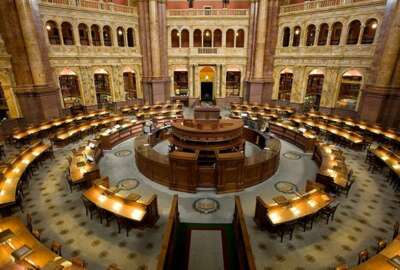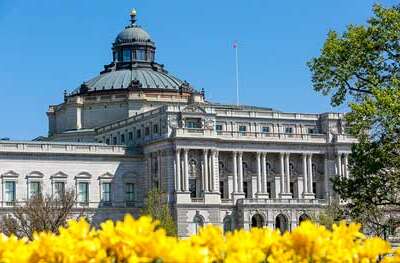The Library of Congress brings personnel strength to a digital initiative
A multi-year project at the Library of Congress aims to bring more black, indigenous and other minority groups closer to the library. It's called, "Of the Peopl...
Best listening experience is on Chrome, Firefox or Safari. Subscribe to Federal Drive’s daily audio interviews on Apple Podcasts or PodcastOne.
A multi-year project at the Library of Congress aims to bring more Black, indigenous and other minority groups closer to the library. It’s called, “Of the People: Widening the Path.” To find out more, the Federal Drive with Tom Temin spoke with the new program director of the project’s digital component, Marya McQuirter.
Interview transcript:
Tom Temin: Tell us about the bigger project here the “Of the People: Widening the Path.” What is it all about? What does it aim to do?
Marya McQuirter: Great. Well, yeah, I’m really excited to talk with you and your listeners directly about this new initiative. It’s called “Of the People: Widening the Path.” And it’s a multi-year initiative that creates new opportunities for more people in the United States to engage with the Library of Congress, to engage with the Library of Congress’s collections and to allow the National Library to share more stories about the U.S. It’s supported by a grant from the Andrew W. Mellon Foundation. And it’s really about promoting outreach technology and innovation and archives development for and by Black, indigenous and other communities of color.
Tom Temin: Is there a sense that those groups don’t have enough of their work that would otherwise be worthy of preservation in the Library of Congress?
Marya McQuirter: Oh, not at all. I mean, there’s a long history of materials by and about Black, indigenous and other communities of color. They go back to the last two centuries, but in response to public demand in response to particular interests around these individuals and in communities. And in response to a national conversation about civil rights the Library of Congress is always expanding and being open, that this was a wonderful opportunity to let everyone know that there are materials, in particularly in my case, digital collections that they can explore.
Tom Temin: Got it. Tell us then about the digital component that you’re working on.
Marya McQuirter: The program that I’m directing, is Connecting Communities Digital Initiative, or CCDI. And with this particular program, we’re focused specifically on digital collections. And obviously, in 2020, with the advent of COVID, people could not come to the library, could not go to the library. And so this was an opportunity to highlight once again, that the Library of Congress has digital collections that you can use from your home. So Connecting Communities Digital Initiatives supports and offers grants to higher education institutions, to libraries, archives and museums, and also to scholars and artists, really, for them to explore the digital collections and reimagine and remix them in new ways and create new projects based on those digital collections.
Tom Temin: And what are some of the pieces in the digital collection? That is, is it older material that has been digitized? And could it also be new materials that were born digital to begin with?
Marya McQuirter: Yes, that’s exactly right, Tom, it is the materials that have been digitized, the Library of Congress has a digital strategy. The CCDI that I’m a part of is also in addition to being part of, Of the People initiative. It’s also within the digital strategy directorate within the Library of Congress. So yes, there are quite a bit a large number of digital collections, collections that have been digitized and also there are also born digital materials as well.
Tom Temin: So for example, if somebody wanted to take the writings of Harriet Tubman, for example, and the materials related to her, which obviously were not created digitally, but may have been digitized, they could combine them in some manner, I guess anybody could with say contemporary music and create whatever it is they wanted to create?
Marya McQuirter: Yes, yes, that’s exactly right. And, you know, the LC Labs, which is also part of the digital strategy directorate, has an innovator in residence program, and one of those innovators created a citizen DJ program that made materials that was in the materials that were in the public domain. Songs that were in the public domain, and so people could, exactly as you’re saying, remix and imagine, reimagine in new ways. Exactly.
Tom Temin: We’re speaking with Marya McQuirter. She is program director of the Connecting Communities Digital Initiative at the Library of Congress. And as I understand it, you are new to the library and new to the federal government. Tell us a little bit about yourself. What’s your background? Where’d you come from?
Marya McQuirter: Thank you, Tom. I am new to the library as an employee. But I also say that I’m also old to the library as well, because, and it feels like home to me because I actually, as a user, I have been using the Library of Congress since the late 1980s for either as a research assistant for my own dissertation research and just projects that I’ve worked on over the years. I feel both new and old in terms of our relationship to the Library of Congress. And actually, I am not new to the federal government either. I worked as a historian at the National Museum of African American History and Culture. That’s part of the Smithsonian.
Tom Temin: Which has an impressive digital program of its own, by the way.
Marya McQuirter: Most definitely, most definitely. I’ve worked actually quite a bit in terms of making the materials available virtually to users as a visual arts historian. So a very wonderful experience. But yes, I am new to the Library of Congress as an employee, for sure. And before coming here really starting full time in January, so just been about a month full time with the library. And before this, I was a faculty member in the Department of History at the University of Arizona, where I actually inaugurated another initiative, focusing on public history there.
Tom Temin: And you were also, when you were at Arizona, you were a faculty member in the Africana Studies Program. How do you distinguish Africana with Africa? What’s the meaning of that word? I haven’t seen that one.
Marya McQuirter: Yeah, that’s an interesting question. While I do want to make clear that I actually was a faculty member in the Department of History, and I was an affiliate faculty member in Africana studies as well as the School of Art. But yeah, Africana Studies, the distinction is Africana relates to notions of the diaspora. So that it’s not necessarily people of African descent on the African continent, but people of African descent in the U.S., in the Caribbean, you know, in Europe, so it’s got a kind of a disasporic feel to it.
Tom Temin: And I wanted to ask you about another earlier project at dc1968, a digital humanities project highlighting art, activism, architecture and everyday life in 1968 in Washington, D.C. And of course, that was a pivotal year for the wrong reason, unfortunately, in Washington, D.C., the assassination of Martin Luther King transformed the city and not in a good way. Tell us a little bit more about that, for those of us that remember it?
Marya McQuirter: OK. Yeah, yeah, the the dc1968 project is a project that I initiated, in part because I feel actually that people have a misunderstanding of 1968. That obviously, the Reverend Dr. Martin Luther King, Jr. being assassinated is an awful thing and a tragic thing. But I think people misunderstand the range of reactions that people had to the assassination of King. So part of what my project was, was really an attempt to get people to read again, rethink and reimagine 1968. It was a moment in which the Poor People’s Campaign was instituted in the summer. It was also a time in which a number of institutions were created and built some institutions that still continue today. And so I wanted to offer a much more broader and much more expansive and fuller understanding of Washington, D.C. throughout the entire year. And I’ll just also say, Tom, part of the reason why I was so invested and continue to be invested in this project is because I am a Washingtonian. I was born and raised here. And so my understanding of the city comes from thinking about it intellectually, and also because I feel it so viscerally, as well. And so I wanted to bring that feel to it.
Tom Temin: Yes, people often forget D.C. is lots of people’s hometown, and not just the international and worldwide famous capitol that you see on television at night.
Marya McQuirter: Exactly, exactly.
Copyright © 2024 Federal News Network. All rights reserved. This website is not intended for users located within the European Economic Area.
Tom Temin is host of the Federal Drive and has been providing insight on federal technology and management issues for more than 30 years.
Follow @tteminWFED






